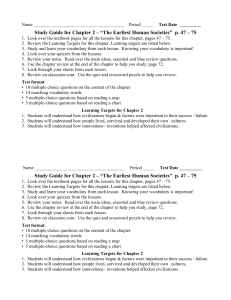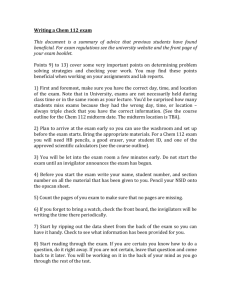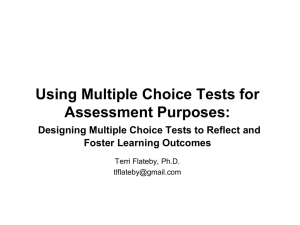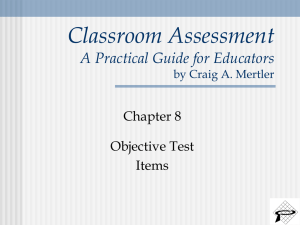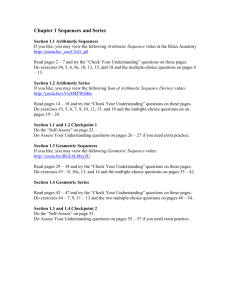Multiple Choice Item
advertisement
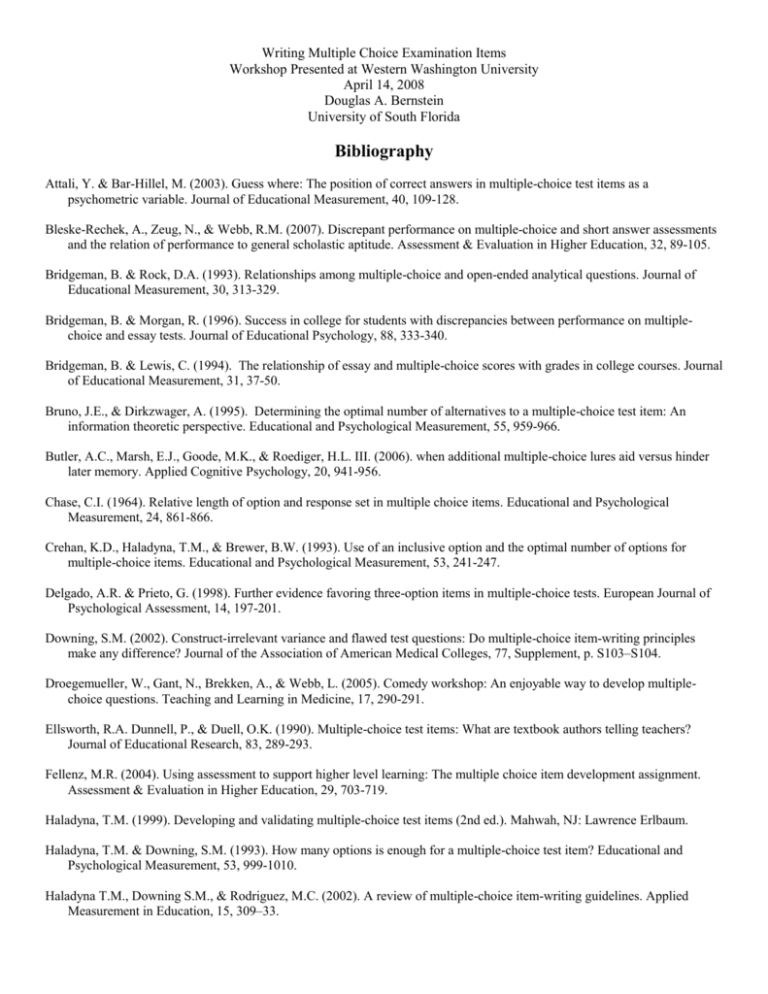
Writing Multiple Choice Examination Items Workshop Presented at Western Washington University April 14, 2008 Douglas A. Bernstein University of South Florida Bibliography Attali, Y. & Bar-Hillel, M. (2003). Guess where: The position of correct answers in multiple-choice test items as a psychometric variable. Journal of Educational Measurement, 40, 109-128. Bleske-Rechek, A., Zeug, N., & Webb, R.M. (2007). Discrepant performance on multiple-choice and short answer assessments and the relation of performance to general scholastic aptitude. Assessment & Evaluation in Higher Education, 32, 89-105. Bridgeman, B. & Rock, D.A. (1993). Relationships among multiple-choice and open-ended analytical questions. Journal of Educational Measurement, 30, 313-329. Bridgeman, B. & Morgan, R. (1996). Success in college for students with discrepancies between performance on multiplechoice and essay tests. Journal of Educational Psychology, 88, 333-340. Bridgeman, B. & Lewis, C. (1994). The relationship of essay and multiple-choice scores with grades in college courses. Journal of Educational Measurement, 31, 37-50. Bruno, J.E., & Dirkzwager, A. (1995). Determining the optimal number of alternatives to a multiple-choice test item: An information theoretic perspective. Educational and Psychological Measurement, 55, 959-966. Butler, A.C., Marsh, E.J., Goode, M.K., & Roediger, H.L. III. (2006). when additional multiple-choice lures aid versus hinder later memory. Applied Cognitive Psychology, 20, 941-956. Chase, C.I. (1964). Relative length of option and response set in multiple choice items. Educational and Psychological Measurement, 24, 861-866. Crehan, K.D., Haladyna, T.M., & Brewer, B.W. (1993). Use of an inclusive option and the optimal number of options for multiple-choice items. Educational and Psychological Measurement, 53, 241-247. Delgado, A.R. & Prieto, G. (1998). Further evidence favoring three-option items in multiple-choice tests. European Journal of Psychological Assessment, 14, 197-201. Downing, S.M. (2002). Construct-irrelevant variance and flawed test questions: Do multiple-choice item-writing principles make any difference? Journal of the Association of American Medical Colleges, 77, Supplement, p. S103–S104. Droegemueller, W., Gant, N., Brekken, A., & Webb, L. (2005). Comedy workshop: An enjoyable way to develop multiplechoice questions. Teaching and Learning in Medicine, 17, 290-291. Ellsworth, R.A. Dunnell, P., & Duell, O.K. (1990). Multiple-choice test items: What are textbook authors telling teachers? Journal of Educational Research, 83, 289-293. Fellenz, M.R. (2004). Using assessment to support higher level learning: The multiple choice item development assignment. Assessment & Evaluation in Higher Education, 29, 703-719. Haladyna, T.M. (1999). Developing and validating multiple-choice test items (2nd ed.). Mahwah, NJ: Lawrence Erlbaum. Haladyna, T.M. & Downing, S.M. (1993). How many options is enough for a multiple-choice test item? Educational and Psychological Measurement, 53, 999-1010. Haladyna T.M., Downing S.M., & Rodriguez, M.C. (2002). A review of multiple-choice item-writing guidelines. Applied Measurement in Education, 15, 309–33. Hancock, G.R. (1994). Cognitive complexity and the comparability of multiple-choice and constructed-response test formats. Journal of Experimental Education, 62, 143-157. Harasym, P.H., Doran, M.L., Brant, R., & Lorscheider, F.L. (1993). Negation in stems of single-response multiple-choice items: An overestimation of student ability. Evaluation & the Health Professions, 16, 342-357. Huang, Y.M. (2005). The impact of the "all-of-the-above" option and student ability in multiple choice testing. Dissertation Abstracts International Section A: Humanities and Social Sciences, 65, 3277. Hughes, H.H. & Trimble, W.E. (1965). The use of complex alternatives in multiple choice items. Educational and Psychological Measurement, 25, 117-126. Knowles, S.L. & Welch, C.A. (1992). A meta-analytic review of item discrimination and difficulty in multiple-choice items using "none-of-the-above." Educational and Psychological Measurement, 52, 571-577. Landrum, R. E., Cashin, J.R., & Theis, K.S. (1993). More evidence in favor of three-option multiple-choice tests. Educational and Psychological Measurement, 53, 771-778. Lukhele, R., Thissen, D., & Wainer, H. (1994). On the relative value of multiple-choice, constructed response, and examineeselected items on two achievement tests. Journal of Educational Measurement, 31, 234-250. Marsh, E.J., Roediger, H.L. III, Bjork, R.A., & Bjork, E.L. (2007). The memorial consequences of multiple-choice testing. Psychonomic Bulletin & Review., 14, 194-199. Neely, D.L., Springston, F.J., & McCann, S.J.H. (1994). Does item order affect performance on multiple choice exams? Teaching of Psychology, 21, 44-45. Owen, S.V. & Froman, R.D. (1987). What's wrong with three-option multiple choice items? Educational and Psychological Measurement, 47, 513-522. Rodriguez, M.C. (2005). Three options are optimal for multiple-choice items: A meta-analysis of 80 years of research. Educational Measurement: Issues and Practice 24 , 3–13. Roediger, H.L. III & Marsh, E.J. (2005). The Positive and Negative Consequences of Multiple-Choice Testing. Journal of Experimental Psychology: Learning, Memory, and Cognition, 31, 1155-1159. Sidick, J.T., Barrett, G.V., & Doverspike, D. (1994). Three-alternative multiple choice tests: An attractive option. Personnel Psychology, 47, 829-835. Skinner, N.F. (1999). When the going gets tough, the tough get going: Effects of item difficulty on multiple-choice test performance. North American Journal of Psychology, 1, 79-82. Stupans, I. (2006). Multiple choice questions: Can they examine application of knowledge? Pharmacy Education, 6, 59-63. Taylor, A.K. (2005). Violating conventional wisdom in multiple choice test construction. College Student Journal, 39, 141-148. Traub, R.E. (1993). On the equivalence of the traits assessed by multiple-choice and constructed-response tests. In R.E. Bennett & W.C. Ward (Eds). (1993). Construction versus choice in cognitive measurement: Issues in constructed response, performance testing, and portfolio assessment. (pp. 29-44). Hillsdale, NJ: Lawrence Erlbaum. Trevisan, M.S., Sax, G., & Michael, W.B. (1991). The effects of the number of options per item and student ability on test validity and reliability. Educational and Psychological Measurement, 51, 829-837.
